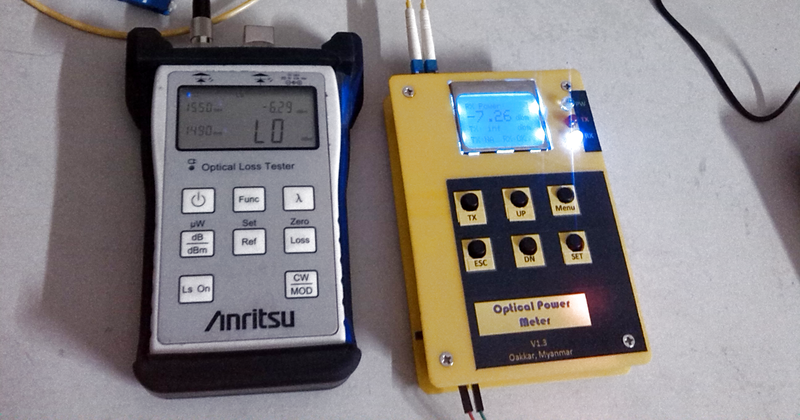This is the type of crowd that’s famous for building their own test equipment. If you need a way to program a flash chip, don’t go out and buy one — you can just build one. Need a spectrum analyzer? You can build that out of copper clad board. For his Hackaday Prize entry, [oakkar7] is building an optical power meter, capable enough to do futzy fiber work, but still completely DIY.
When you get into networking and telecom connections that don’t begin with the letters ‘RJ’, you start to stumble upon SPF transceivers. These ‘small form factor pluggable’ devices are little modular transceivers capable of handling fiber, Gigabit Ethernet, and other slightly weirder bit pipes. When used with fiber, they can measure optical power in dBm and watts, and can be debugged by a UART.
[oakkar]’s optical power meter uses these SPF transceivers, tied together with a fairly simple circuit consisting of an Arduino, a few tact switches, a Nokia LCD, and an FTDI UART. The key in tying all of this together is an Arduino library for SPF and DDM (Digital Diagnostics Monitoring), giving the user access to all the configuration bits in these transceivers.
While the circuit is simple enough to be built on a piece of perfboard, [oakkar] really knocked it out of the park with the enclosure on this one. With just a little bit of laser cut acrylic and a few standoffs, [oakkar] has a device that actually looks professional, and has most of the capabilities of fancier, more expensive tools.




















SPF or SFP? :) “…optical power meter uses these SPF transceivers…”
Lasers can be dangerous, so you need that Sun Protection Factor!
And I’m always sure to bring my Small Form-factor Pluggable with me when I plan to spend time under the sun!
It is SFP (Small Form-factor Pluggable transceiver). I wrote firmware for the SFP, SFP+, and XFP modules from JDSU, before they split into VIAVI and Lumentum.
DIE IN A FIRE you blue LED
Not the first time this week i’ve seen someone hate on blue LEDs. Genuinely curious – what the beef?
Some of us see them as blurs because our eyes can’t focus on that wavelength. Very bright blurs that cause eyestrain.
Also, most of them seem to be set to an intensity level that will induce instant blindness.
I pulled up behind a car waiting at a red light a couple years ago.
The intensity of the LEDs in its 3rd Brake Light was painful!
It’s not just blue, although our eyes are more sensitive that way. But it’s also not just LEDs either. I find some of the newer headlights rather uncomfortable to look at.
Yep, an old nokia I inherited from a friend temporarly blinded me. I had taken off the case, as it was dirty and broken, and I was playing a game of snake when I began to see blind spots growing in my vision.
PAIN
https://jamanetwork.com/journals/jamaophthalmology/fullarticle/1214814#esa120004f1
http://www.sciencedirect.com/science/article/pii/S0014483512002898
Less is more.
LOL LOL
hah yup, cooy that.
hows the cheese sandwhich gig going dave?
I’m gonna be that pedantic asshole today and point out that SFPs don’t use UART for management, they use I2C (or “two wire serial port interface” because Philips was jerks until the mid ’00s).
Okay, but I think it will be my turn to be the PA of the Day tomorrow!
Deal.
What a wonderful world wide web it would be if PAs could really be restricted to just one per day.
Yes chango, the module is managed with I2C by Arduino. UART is just for debugging in my code such as reading raw register, status and control bits etc.
Oh nice. I did this a couple years ago at work. I have a pair of testers that modulate the light to send data, so if there is a link the remote end gets a signal containing the power from the other tester. So at both ends the screen shows the RX power at both ends :)
No buttons other than on/off on mine and they wirelessly charge too.
Yes Pyrofer, like you said , I am thinking to send data also. The problem is how to bridge low speed arduino pin and high speed (100 mbps) SFP module data I/O pins. Seem I need to do with high-interface chip or Ethernet integrated MCU like PIC32, arm mbed etc.
you’d need a dark chamber for you caibration as well…
Yes, thanks and noted for this.
Thanks all for interest.
Like ScriptGiddy says: it is SFP, not SPF.
And the case is not laser-cut. It is cut by hand scroll saw.
For safety, my SPF module (most module >= 10km range) uses Class-1 laser. So, it is safe to handle in normal condition. There are various range/speed/type of SFP modules (like long haul DWDM modules) may use different class and output powers level. So, take care your own.
For BLUE LEDs SUCK: Thanks for your shared infos. Actually, I also feel inconvenience of looking LEDs brightness. I will replace normal LEDs and adjust series resistors. For nokia lcd, I cannot replace the back light LED. I may add back light adjustment with PWM for it.
Came looking for something to use with my 100W CO2 laser cutter. I guess this isn’t it…